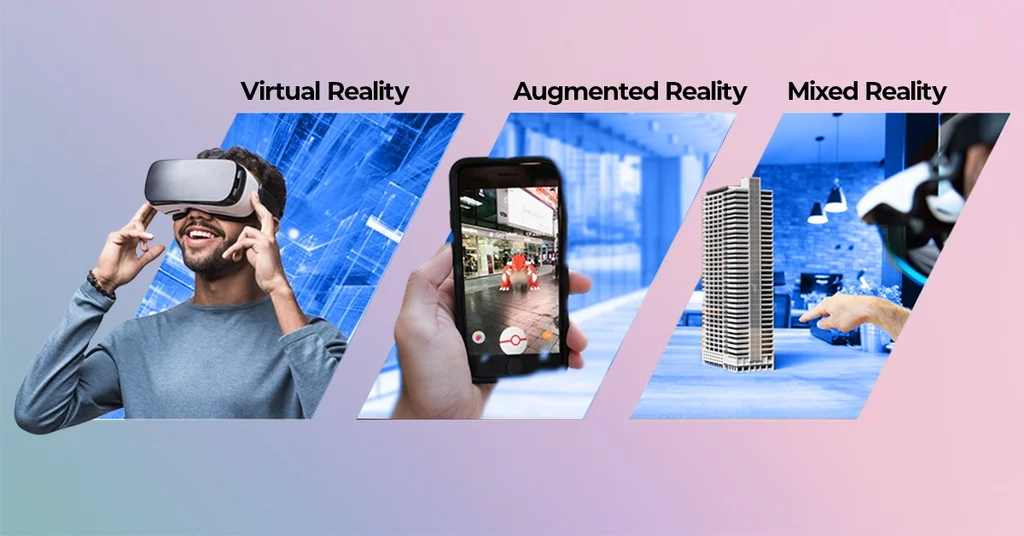In the ever-evolving world of technology, the terms Augmented Reality (AR) and Virtual Reality (VR) often spark debates among developers, businesses, and consumers. Both are integral to the future of Mixed Reality, a field that blends the digital and physical worlds in ways we never imagined. But what’s next for AR and VR, and how will these technologies shape our future? Let’s dive into the differences, potential, and next steps for AR and VR app development.
What is Augmented Reality (AR)?
Augmented Reality (AR) overlays digital content onto the real world. It enhances your environment by adding images, sounds, and other sensory inputs through devices like smartphones, tablets, and AR glasses. The best part? You continue to interact with your physical surroundings while enjoying the digital enhancements. Popular apps like Pokémon GO and Google Lens showcase AR’s potential, offering users a seamless blend of reality and digital elements.
Businesses are realizing the power of AR in improving customer experiences. Imagine trying on clothes virtually, or previewing how a piece of furniture fits in your living room before making a purchase. AR is revolutionizing retail, education, and even healthcare by offering more immersive, interactive experiences.
What is Virtual Reality (VR)?
On the other hand, Virtual Reality (VR) immerses users in a completely digital world. Using a VR headset, users are transported into a new environment where they can interact with digital elements as if they were real. VR has been popularized in gaming, with experiences like Oculus Rift and PlayStation VR offering fully immersive worlds for players to explore.
But VR is not just limited to gaming. It’s transforming industries such as healthcare, education, and entertainment. Medical students use VR to practice surgeries, and VR simulations are used in training military personnel and emergency responders. With VR, users can experience environments that are either too dangerous, expensive, or simply impossible to access in the real world.
AR and VR in the Business World
The business world is waking up to the vast potential of AR and VR, leading to rapid growth in these fields. Companies are adopting AR and VR technologies to provide better customer service, improve training programs, and even streamline product design.
As more companies realize the value of these technologies, the demand for AR and VR apps is growing exponentially. Businesses are turning to VR app development companies and AR app development companies to create custom solutions for their unique needs.
If you’re a business owner looking to integrate AR or VR into your operations, you might want to hire a dedicated development team to ensure your project is executed flawlessly. An experienced development team will bring your vision to life, using the latest tools and techniques to deliver high-quality apps that enhance user experience and engagement.
Augmented Reality vs. Virtual Reality: Key Differences
While both AR and VR are immersive technologies, there are distinct differences between them.
- User Interaction with the Real World
- AR allows users to interact with both digital and real-world elements simultaneously. You can see the world around you, but with added digital enhancements.
- VR, however, isolates users from the real world. Once you put on a VR headset, you’re immersed in a completely digital world.
- Hardware Requirements
- AR is more accessible because it often only requires a smartphone or tablet. With wearable devices like AR glasses coming into play, the potential is endless.
- VR requires more specialized hardware, typically a VR headset and motion controllers. Some VR experiences also need a high-end computer or gaming console.
- Applications
- AR is perfect for enhancing everyday activities like shopping, navigating, or learning. It’s great for apps that provide additional context to the physical world.
- VR, on the other hand, is ideal for creating completely new environments or simulations, like immersive gaming or training simulations.
What’s Next for Mixed Reality?
The next frontier for AR and VR is the concept of Mixed Reality (MR), which takes the best elements of AR and VR and merges them into one seamless experience. Imagine combining the immersive nature of VR with the ability to interact with the real world like AR. That’s Mixed Reality.
With advancements in hardware, especially in AR glasses and VR headsets, the line between the physical and virtual world is becoming increasingly blurred. The future of MR is all about creating environments where users can seamlessly move between the real world and the digital world, without even noticing the transition.
The Future of AR and VR Technologies
Looking forward, AR and VR technologies will continue to evolve and integrate with other cutting-edge technologies. Here’s what we can expect:
- 5G and Cloud Computing
- The advent of 5G technology will revolutionize AR and VR experiences by offering faster, more reliable connectivity. Cloud computing will also allow for more complex processing, making AR and VR apps faster and more powerful.
- Improved Hardware
- Future AR glasses and VR headsets will be lighter, more comfortable, and more affordable, making them accessible to a wider audience. Expect to see more compact devices that don’t compromise on performance.
- More Immersive Experiences
- As the technology matures, the experiences will become more immersive. Expect haptic feedback, scent generation, and even taste simulations as part of the AR and VR experience. This will make virtual environments feel even more lifelike.
- Enterprise Applications
- Industries like manufacturing, healthcare, and real estate are set to benefit from AR and VR in unprecedented ways. Businesses can use these technologies for training, product visualization, and more, streamlining operations and cutting costs.
How to Leverage AR and VR for Your Business
If you’re considering integrating AR or VR into your business, working with VR app development companies is a great first step. These companies specialize in creating tailored solutions for businesses, ensuring your AR or VR app meets your objectives and delivers a seamless experience.
Hiring a VR app development company to build custom VR applications allows you to provide customers with engaging, immersive experiences, whether it’s for virtual product demos, training simulations, or entertainment.
If you need a larger team to bring your AR/VR vision to life, you can hire a dedicated development team that specializes in both AR and VR. This team will work closely with you, understand your business needs, and build high-quality apps designed for optimal user experience.
Conclusion
As AR and VR technologies continue to evolve, their potential for transforming industries is limitless. Whether you choose to leverage AR to enhance the real world or VR to create entirely new digital environments, there’s no doubt that Mixed Reality will be a driving force in shaping the future.
For businesses looking to stay ahead of the curve, it’s time to explore the world of AR and VR. Partner with a VR app development company and AR app development companies to take advantage of these cutting-edge technologies and deliver exceptional experiences to your users.




